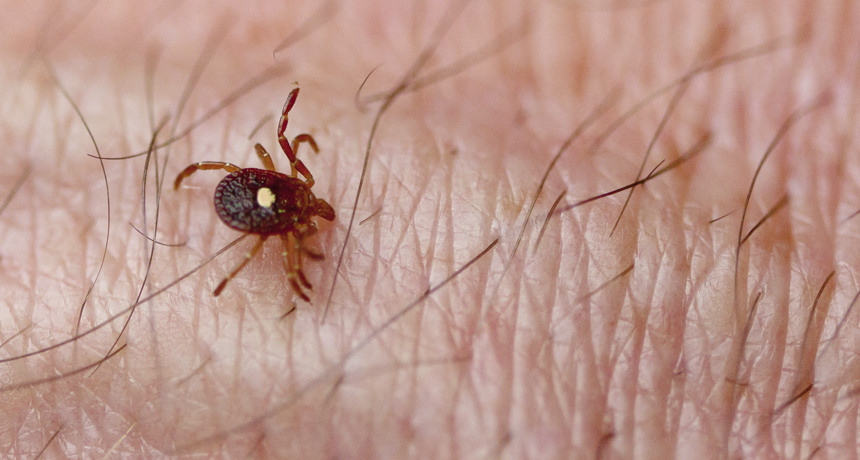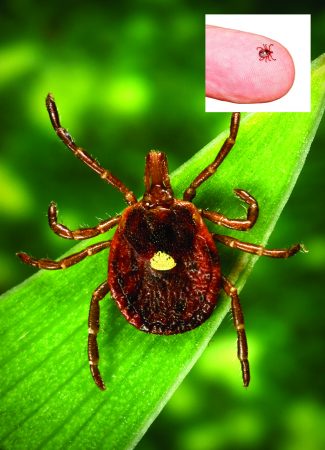New ‘Heartland’ disease emerges in U.S. Midwest
Carried by the Lone Star tick, it has no treatment or cure

A Lone Star tick shown on a hairy arm. This parasite can host a virus. In humans, that virus triggers an infection that resembles an especially severe case of flu.
epantha/istockphoto
By Janet Raloff
A rare but serious virus infection has emerged in the central United States, a team of doctors has just reported. The virus causes fever, a drop in the blood’s infection-fighting white cells and a reduction in the blood’s clot-making platelets. Called Heartland disease, its name honors the Heartland Regional Medical Center in St. Joseph, Mo. That’s where the first men infected with the virus were treated. To date, there have been eight confirmed cases.
Researchers outline how the mystery disease was discovered in the March 28 Morbidity and Mortality Weekly Report. They also describe the potential impacts of the virus. Seven men became very sick with the disease but recovered. The eighth man died, the scientists report, although he had also been sick with other conditions.
The disease was first noticed in June 2009. That’s when two Missouri farmers came to the hospital with severe flu-like symptoms. They reported headaches, nausea, high fevers, diarrhea and gut-distress. And they were very, very tired. Blood tests showed the men had low white-blood-cell counts.
Both men reported they had been recently bitten by ticks. The first man said his wife used tweezers to remove a tick from the trunk of his body the day before his fever began. The second farmer had been “ticked” liberally. He told doctors he had averaged 20 tick bites a day for almost two weeks. His last tick bite had been about three days before his fever struck.

Local doctors alerted the Centers for Disease Control and Prevention. Experts at this CDC found the virus — and confirmed it was a new one. The virus was also an unusual type, a phlebovirus (FLEE bo VI russ). Flies, mosquitoes and ticks tend to spread this kind of germ — but this type of virus had never been seen in the United States. So the Missouri patients had the first American phlebovirus disease. Laura McMullan of the CDC and her colleagues described the unusual germ in the Aug. 30, 2012, New England Journal of Medicine.
Although doctors suspected the virus came from the bite of an infected tick, they couldn’t be sure. So Harry Savage of the CDC in Fort Collins, Colo., and his colleagues stepped in.
They hunted ticks at 12 sites, including the farms belonging to the first two Missouri patients. In all, they collected 56,428 of the tiny animals. There were three different species of ticks in their collection. But only the Lone Star ticks (Amblyomma americanum), named for the bright yellow emblem on their backs, hosted any of the new virus. The Savage team reported its findings last July 22 in the American Journal of Tropical Medicine and Hygiene.
As this work was going on, another six cases of Heartland disease were confirmed; five in Missouri and one in Tennessee. All the patients were men aged 50 or older (as the first farmers had been). Five recalled having tick bites in the days right before their symptoms developed. And all worked outdoors or engaged in frequent outdoorsy hobbies, such as gardening, hunting or hiking.
It took time, but seven of the infected men, including the two first diagnosed with the disease, eventually recovered.
“No vaccine or medication is available to prevent or treat Heartland virus disease,” notes Daniel Pastula of the CDC in Fort Collins and his team in their new report. So the only way to be protected from the disease is by preventing exposure to it. The CDC doctors recommend applying insect repellents when going into bushy or wooded grounds. They also suggest wearing long sleeves and pants — and checking for signs of ticks every time you come in from woodsy sites.
Power Words
antibiotic A germ-killing substance prescribed as a medicine (or sometimes as a feed additive to promote the growth of livestock). It does not work against viruses.
platelets The smallest of blood cells, their role is to search for signs that a vessel has been damaged. Then they congregate at the site of damage and transform themselves, growing long tentacles. There they link together, creating a clot to plug any hole — stemming the potential loss of blood.
Centers for Disease Control and Prevention, or CDC An agency of the U.S. Department of Health and Human Services, CDC is charged with protecting public health and safety by working to control and prevent disease, injury and disabilities. It does this by investigating disease outbreaks, tracking exposures by Americans to infections and toxic chemicals, and regularly surveying diet and other habits among a representative cross-section of all Americans.
parasite An organism that gets benefits from another species, called a host, but doesn’t provide it any benefits. Classic examples of parasites include ticks, fleas and tapeworms.
tick A small eight-legged blood-sucking arthropod, related to spiders and mites. Although they look like bugs, these are not insects. They attach themselves to the skin of their host and feed on their blood. But in the process, they may spread any germs that could have been present in the blood of an earlier host.
vaccine A biological mixture that resembles a disease-causing agent. It is given to help the body create immunity to a particular disease.
virus Tiny infectious particles consisting of RNA or DNA surrounded by protein. Viruses can reproduce only by injecting their genetic material into the cells of living creatures. Although scientists frequently refer to viruses as live or dead, in fact no virus is truly alive. It doesn’t eat like animals do, or make its own food the way plants do. It must hijack the cellular machinery of a living cell in order to survive.
white blood cells Blood cells that help the body fight off infection.







